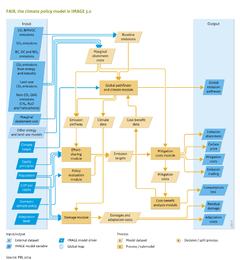Climate policy/Policy issues: Difference between revisions
Jump to navigation
Jump to search
No edit summary |
No edit summary |
||
| Line 4: | Line 4: | ||
|Example=As part of the IMAGE framework, FAIR can be used to evaluate a range of policies and strategies, including: | |Example=As part of the IMAGE framework, FAIR can be used to evaluate a range of policies and strategies, including: | ||
*Long-term mitigation strategies such as emission reductions over time (Den Elzen et al., 2007; Den Elzen and Van Vuuren, 2007; Van Vliet et al., 2009; Van Vuuren et al., 2011b; 2012); | *Long-term mitigation strategies such as emission reductions over time ([[Den Elzen et al., 2007]]; [[Den Elzen and Van Vuuren, 2007]]; [[Van Vliet et al., 2009]]; [[Van Vuuren et al., 2011b]]; [[Van Vuuren et al., 2012|2012]]); | ||
*Evaluation of current reduction proposals by countries and policy options for the next 10 to 20 years (European Commission, 2010; Den Elzen et al., 2011a; 2011b; 2012b; UNEP, 2012; Hof et al., 2013); | *Evaluation of current reduction proposals by countries and policy options for the next 10 to 20 years ([[European Commission, 2010]]; [[Den Elzen et al., 2011a]]; [[Den Elzen et al., 2011b|2011b]]; [[Den Elzen et al., 2012b|2012b]]; [[UNEP, 2012]]; [[Hof et al., 2013]]); | ||
*Evaluation of domestic climate and energy policies for the next 10 to 20 years (Höhne et al., 2012; Roelfsema et al., 2013; 2014); | *Evaluation of domestic climate and energy policies for the next 10 to 20 years ([[Höhne et al., 2012]]; [[Roelfsema et al., 2013]]; [[Roelfsema et al., 2014|2014]]); | ||
*Evaluation of burden sharing or effort sharing regimes (Den Elzen and Höhne, 2010; Den Elzen et al., 2012a; Hof et al., 2012); | *Evaluation of burden sharing or effort sharing regimes ([[Den Elzen and Höhne, 2010]]; [[Den Elzen et al., 2012a]]; [[Hof et al., 2012]]); | ||
*Analysis of regional abatement costs and emission trading (Den Elzen et al., 2008; Den Elzen et al., 2011a; Mendoza Beltrán et al., 2011); | *Analysis of regional abatement costs and emission trading ([[Den Elzen et al., 2008]]; [[Den Elzen et al., 2011a]]; [[Mendoza Beltrán et al., 2011]]); | ||
*Evaluation of proposals for financing climate policies (Hof et al., 2009; | *Evaluation of proposals for financing climate policies ([[Hof et al., 2009]]; [[Hof et al., 2011|2011]]); | ||
The FAIR Policy Evaluation module has been used in determining emission reductions resulting from pledges made for 2020 (Den Elzen et al., 2012c). In 2011, Brazil presented a new, higher estimate for national business-as-usual (BAU) emissions, against which a 36 to 39% reduction pledge was made. The total pledge for all greenhouse gas emissions including emissions from deforestation was a reduction of 20 to 24% compared to the PBL/IIASA BAU emission projections. This reduction is substantially lower than pledged by Brazil from national BAU projections . | * Evaluation of trade-offs between mitigation costs, adaptation costs and the benefits of reduced climate damage ([[Hof et al., 2008]]; [[Hof et al., 2009|2009]]; [[Hof et al., 2010|2010]]). | ||
The FAIR Policy Evaluation module has been used in determining emission reductions resulting from pledges made for 2020 ([[Den Elzen et al., 2012c]]). In 2011, Brazil presented a new, higher estimate for national business-as-usual ({{abbrTemplate|BAU}}) emissions, against which a 36 to 39% reduction pledge was made. The total pledge for all greenhouse gas emissions including emissions from deforestation was a reduction of 20 to 24% compared to the PBL/IIASA BAU emission projections. This reduction is substantially lower than pledged by Brazil from national {{abbrTemplate|BAU}} projections . | |||
Revision as of 14:05, 15 May 2014
Parts of Climate policy/Policy issues
